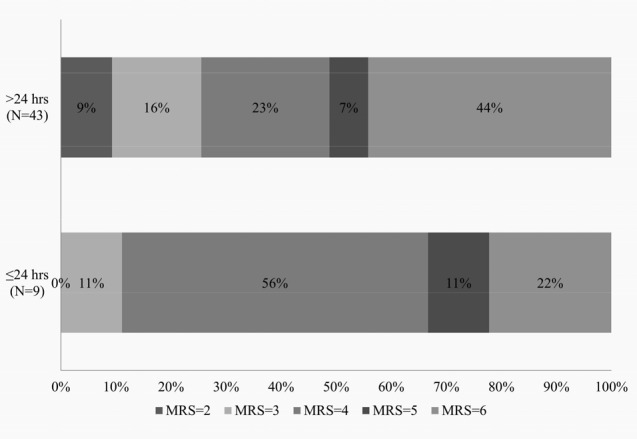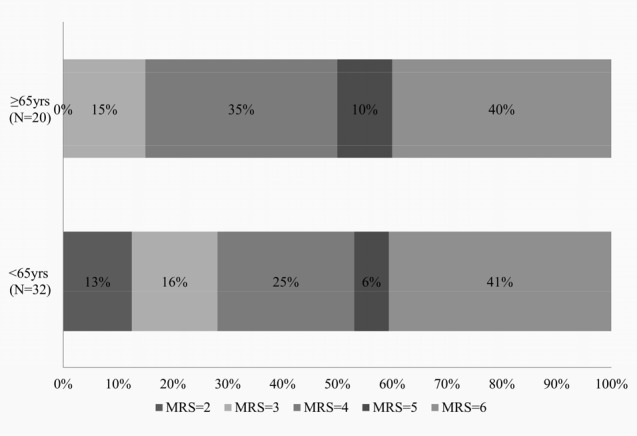J Cerebrovasc Endovasc Neurosurg.
2016 Sep;18(3):175-184. 10.7461/jcen.2016.18.3.175.
Analysis of the Outcome and Prognostic Factors of Decompressive Craniectomy between Young and Elderly Patients for Acute Middle Cerebral Artery Infarction
- Affiliations
-
- 1Department of Neurosurgery, Gachon University, Gil Medical Center, Incheon, Korea. nschan@gilhospital.com
- KMID: 2355639
- DOI: http://doi.org/10.7461/jcen.2016.18.3.175
Abstract
OBJECTIVE
We compared the effect of decompressive craniectomy between patients < 65 and ≥ 65 years age and investigated prognostics factors that may help predict favorable outcome in acute stroke patients undergoing decompressive surgery.
MATERIALS AND METHODS
52 patients diagnosed with acute middle cerebral artery (MCA) territory infarction that underwent decompressive craniectomy were retrospectively reviewed. The outcome of all patients were evaluated by assessing the Glasgow coma scale, Glasgow outcome scale (GOS), and Modified Rankin scale (mRS) six months after the onset of the disease. 21 patients were preoperatively evaluated with a computed tomography angiography (CTA). Leptomeningeal collateral (LMC) circulation was graded using CTA by experienced neurosurgeons to assess its prognostic value.
RESULTS
The thirty day mortality for patients ≥ 65 was 35.0% compared to 37.5% in patients < 65. There was no significant difference in the clinical and function outcome between the two groups (4.8 ± 1.2 vs. 4.5 ± 1.5, p = 0.474). Mortality was lower with early surgery (within 24 hours) group for both age groups (25% vs. 37.5% in ≥ 65, 20% vs. 40.7% in < 65). Longer intensive care units stay time and good collateral supply score were correlated with favorable outcome (p = 0.028, p = 0.018).
CONCLUSION
Decompressive craniectomy within 24 hours of stroke symptom onset improved survival in both the < 65 and ≥ 65 age groups. There was no significant difference in the functional outcome of both age groups. Unlike previous reports, old age, delayed operation, and multiple of infarct territories were not predictive of poor functional outcome. The presence of good collateral circulation may be a predictor of positive clinical outcome in acute ischemic stroke patients undergoing decompressive craniectomy.
Keyword
MeSH Terms
Figure
Reference
-
1. Agarwalla PK, Stapleton CJ, Ogilvy CS. Craniectomy in acute ischemic stroke. Neurosurgery. 2014; 2. 74(Suppl 1):S151–S162. PMID: 24402484.
Article2. Chen CC, Cho DY, Tsai SC. Outcome of and prognostic factors for decompressive hemicraniectomy in malignant middle cerebral artery infarction. J Clin Neurosci. 2007; 4. 14(4):317–321. PMID: 17275311.
Article3. Curry WT Jr, Sethi MK, Ogilvy CS, Carter BS. Factors associated with outcome after hemicraniectomy for large middle cerebral artery territory infarction. Neurosurgery. 2005; 4. 56(4):681–692. discussion 681-92. PMID: 15792506.
Article4. Fink JN, Selim MH, Kumar S, Silver B, Linfante I, Caplan LR, et al. Is the association of National Institutes of Health Stroke Scale scores and acute magnetic resonance imaging stroke volume equal for patients with right- and left-hemisphere ischemic stroke? Stroke. 2002; 4. 33(4):954–958. PMID: 11935043.
Article5. Hacke W, Schwab S, Horn M, Spranger M, De Georgia M, von Kummer R. 'Malignant' middle cerebral artery territory infarction: clinical course and prognostic signs. Arch Neurol. 1996; 4. 53(4):309–315. PMID: 8929152.6. Juttler E, Unterberg A, Woitzik J, Bosel J, Amiri H, Sakowitz OW, et al. Hemicraniectomy in older patients with extensive middle-cerebral-artery stroke. N Engl J Med. 2014; 3. 370(12):1091–1100. PMID: 24645942.
Article7. Kilincer C, Asil T, Utku U, Hamamcioglu MK, Turgut N, Hicdonmez T, et al. Factors affecting the outcome of decompressive craniectomy for large hemispheric infarctions: a prospective cohort study. Acta Neurochir (Wien). 2005; 6. 147(6):587–594. discussion 594. PMID: 15739038.
Article8. Kissela B, Schneider A, Kleindorfer D, Khoury J, Miller R, Alwell K, et al. Stroke in a biracial population: the excess burden of stroke among blacks. Stroke. 2004; 2. 35(2):426–431. PMID: 14757893.9. Koh MS, Goh KY, Tung MY, Chan C. Is decompressive craniectomy for acute cerebral infarction of any benefit? Surg Neurol. 2000; 3. 53(3):225–230. PMID: 10773253.
Article10. Maas MB, Lev MH, Ay H, Singhal AB, Greer DM, Smith WS, et al. Collateral vessels on CT angiography predict outcome in acute ischemic stroke. Stroke. 2009; 9. 40(9):3001–3005. PMID: 19590055.
Article11. Miteff F, Levi CR, Bateman GA, Spratt N, McElduff P, Parsons MW. The independent predictive utility of computed tomography angiographic collateral status in acute ischaemic stroke. Brain. 2009; 8. 132(Pt 8):2231–2238. PMID: 19509116.
Article12. Rahme R, Zuccarello M, Kleindorfer D, Adeoye OM, Ringer AJ. Decompressive hemicraniectomy for malignant middle cerebral artery territory infarction: is life worth living? J Neurosurg. 2012; 10. 117(4):749–754. PMID: 22920962.
Article13. Schwab S, Steiner T, Aschoff A, Schwarz S, Steiner HH, Jansen O, et al. Early hemicraniectomy in patients with complete middle cerebral artery infarction. Stroke. 1998; 9. 29(9):1888–1893. PMID: 9731614.
Article14. Vahedi K, Hofmeijer J, Juettler E, Vicaut E, George B, Algra A, et al. Early decompressive surgery in malignant infarction of the middle cerebral artery: a pooled analysis of three randomised controlled trials. Lancet Neurol. 2007; 3. 6(3):215–222. PMID: 17303527.
Article
- Full Text Links
- Actions
-
Cited
- CITED
-
- Close
- Share
- Similar articles
-
- Management Outcome and Prognostic Factors of Patients who Underwent Decompressive Craniectomy for Space-Occupying Cerebral Infarction
- Efficacy of the Decompressive Craniectomy for Acute Cerebral Infarction: Timing of Surgical Intervention and Clinical Prognostic Factors
- Clinical Comparison between Simple Craniectomy and Lesionectomy in the Patients with Acute Cerebral Infarction
- Surgical Management of Acute Infarction
- Outcome Following Decompressive Craniectomy for Malignant Middle Cerebral Artery Infarction in Patients Older Than 70 Years Old




